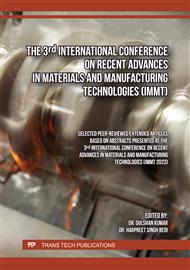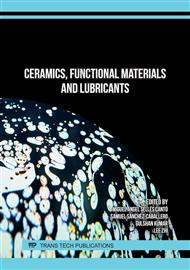[1]
K.O. Yoro, M.O. Daramola, CO2 emission sources, greenhouse gases, and the global warming effect, Elsevier Inc., 2020.
DOI: 10.1016/B978-0-12-819657-1.00001-3
Google Scholar
[2]
J.G.J. and P.J.A.H.. Olivier, TRENDS IN GLOBAL CO2 AND TOTAL GREENHOUSE GAS Emission Report, PBL Netherlands Environ. Assess. Agency. (2020) 1–85.
Google Scholar
[3]
S. Nazar, J. Yang, M. Ashraf, F. Aslam, M.F. Javed, S.M. Eldin, J. Xie, Formulation and characterization of cleaner one-part novel fly ash/lime-based alkali-activated material, J. Mater. Res. Technol. 23 (2023) 3821–3839.
DOI: 10.1016/j.jmrt.2023.02.022
Google Scholar
[4]
E. Benhelal, G. Zahedi, E. Shamsaei, A. Bahadori, Global strategies and potentials to curb CO2 emissions in cement industry, J. Clean. Prod. 51 (2013) 142–161.
DOI: 10.1016/j.jclepro.2012.10.049
Google Scholar
[5]
N. Palankar, Performance of Alkali Activated Concrete Mixes With Steel Slag As Coarse, (2016) 1–194. https://idr.nitk.ac.in/jspui/handle/123456789/14263.
Google Scholar
[6]
R. Snellings, Assessing, Understanding and Unlocking Supplementary Cementitious Materials, RILEM Tech. Lett. 1 (2016) 50.
DOI: 10.21809/rilemtechlett.2016.12
Google Scholar
[7]
C. Shi, B. Qu, J.L. Provis, Recent progress in low-carbon binders, Cem. Concr. Res. 122 (2019) 227–250.
DOI: 10.1016/j.cemconres.2019.05.009
Google Scholar
[8]
M.D. Ikramullah Khan, M.A. Abdy Sayyed, G. Swamy Yadav, S. Haripriya Varma, The impact of fly ash and structural fiber on the mechanical properties of concrete, Mater. Today Proc. 39 (2020) 508–512.
DOI: 10.1016/j.matpr.2020.08.242
Google Scholar
[9]
M.I. Khan, M.A. Abdy Sayyed, M.M.A. Ali, Examination of cement concrete containing micro silica and sugarcane bagasse ash subjected to sulphate and chloride attack, Mater. Today Proc. 39 (2021) 558–562. https://doi.org/.
DOI: 10.1016/j.matpr.2020.08.468
Google Scholar
[10]
J.I. Escavy, M.J. Herrero, F. Lopez-Acevedo, L. Trigos, The progressive distancing of aggregate quarries from the demand areas: Magnitude, causes, and impact on CO2 emissions in Madrid Region (1995–2018), Resour. Policy. 75 (2022) 102506.
DOI: 10.1016/j.resourpol.2021.102506
Google Scholar
[11]
M. Quattrone, S.C. Angulo, V.M. John, Energy and CO2 from high performance recycled aggregate production, Resour. Conserv. Recycl. 90 (2014) 21–33.
DOI: 10.1016/j.resconrec.2014.06.003
Google Scholar
[12]
V.W.Y. Tam, M. Soomro, A.C.J. Evangelista, A review of recycled aggregate in concrete applications (2000–2017), Constr. Build. Mater. 172 (2018) 272–292.
DOI: 10.1016/j.conbuildmat.2018.03.240
Google Scholar
[13]
L. Huang, G. Krigsvoll, F. Johansen, Y. Liu, X. Zhang, Carbon emission of global construction sector, Renew. Sustain. Energy Rev. 81 (2018) 1906–1916.
DOI: 10.1016/j.rser.2017.06.001
Google Scholar
[14]
A. Rafeet, R. Vinai, M. Soutsos, W. Sha, Effects of slag substitution on physical and mechanical properties of fly ash-based alkali activated binders (AABs), Cem. Concr. Res. 122 (2019) 118–135.
DOI: 10.1016/j.cemconres.2019.05.003
Google Scholar
[15]
J. Wang, T. Huang, G. Cheng, Z. Liu, S. Li, D. Wang, Effects of fly ash on the properties and microstructure of alkali-activated FA/BFS repairing mortar, Fuel. 256 (2019) 115919.
DOI: 10.1016/j.fuel.2019.115919
Google Scholar
[16]
K. Parthiban, K. Saravana Raja Mohan, Influence of recycled concrete aggregates on the engineering and durability properties of alkali activated slag concrete, Constr. Build. Mater. 133 (2017) 65–72.
DOI: 10.1016/j.conbuildmat.2016.12.050
Google Scholar
[17]
X.S. Shi, F.G. Collins, X.L. Zhao, Q.Y. Wang, Mechanical properties and microstructure analysis of fly ash geopolymeric recycled concrete, J. Hazard. Mater. 237–238 (2012) 20–29.
DOI: 10.1016/j.jhazmat.2012.07.070
Google Scholar
[18]
G. Fang, W.K. Ho, W. Tu, M. Zhang, Workability and mechanical properties of alkali-activated fly ash-slag concrete cured at ambient temperature, Constr. Build. Mater. 172 (2018) 476–487.
DOI: 10.1016/j.conbuildmat.2018.04.008
Google Scholar
[19]
A. Sedaghatdoost, K. Behfarnia, M. Bayati, M. sadegh Vaezi, Influence of recycled concrete aggregates on alkali-activated slag mortar exposed to elevated temperatures, J. Build. Eng. 26 (2019) 100871.
DOI: 10.1016/j.jobe.2019.100871
Google Scholar
[20]
J. Xie, J. Wang, R. Rao, C. Wang, C. Fang, Effects of combined usage of GGBS and fly ash on workability and mechanical properties of alkali activated geopolymer concrete with recycled aggregate, Compos. Part B Eng. 164 (2019) 179–190.
DOI: 10.1016/j.compositesb.2018.11.067
Google Scholar
[21]
G. Fang, M. Zhang, The evolution of interfacial transition zone in alkali-activated fly ash-slag concrete, Cem. Concr. Res. 129 (2020) 105963.
DOI: 10.1016/j.cemconres.2019.105963
Google Scholar
[22]
W. Wang, T. Noguchi, Alkali-silica reaction (ASR) in the alkali-activated cement (AAC) system: A state-of-the-art review, Constr. Build. Mater. 252 (2020) 119105.
DOI: 10.1016/j.conbuildmat.2020.119105
Google Scholar
[23]
A.S. De Vargas, D.C.C. Dal Molin, A.C.F. Vilela, F.J. Da Silva, B. Pavão, H. Veit, The effects of Na2O/SiO2 molar ratio, curing temperature and age on compressive strength, morphology and microstructure of alkali-activated fly ash-based geopolymers, Cem. Concr. Compos. 33 (2011) 653–660.
DOI: 10.1016/j.cemconcomp.2011.03.006
Google Scholar
[24]
M.M.A. Elahi, M.M. Hossain, M.R. Karim, M.F.M. Zain, C. Shearer, A review on alkali-activated binders: Materials composition and fresh properties of concrete, Constr. Build. Mater. 260 (2020) 119788.
DOI: 10.1016/j.conbuildmat.2020.119788
Google Scholar
[25]
B. Wang, L. Yan, Q. Fu, B. Kasal, A Comprehensive Review on Recycled Aggregate and Recycled Aggregate Concrete, Resour. Conserv. Recycl. 171 (2021) 105565.
DOI: 10.1016/j.resconrec.2021.105565
Google Scholar
[26]
J.H. Kim, J.H. Sung, C.S. Jeon, S.H. Lee, H.S. Kim, A study on the properties of recycled aggregate concrete and its production facilities, Appl. Sci. 9 (2019).
DOI: 10.3390/app9091935
Google Scholar
[27]
F. de Andrade Salgado, F. de Andrade Silva, Recycled aggregates from construction and demolition waste towards an application on structural concrete: A review, J. Build. Eng. 52 (2022) 104452. https://doi.org/.
DOI: 10.1016/j.jobe.2022.104452
Google Scholar
[28]
F.U. Ahmed Shaikh, P. Nath, A. Hosan, M. John, W.K. Biswas, Sustainability assessment of recycled aggregates concrete mixes containing industrial by-products, Mater. Today Sustain. 5 (2019) 100013.
DOI: 10.1016/j.mtsust.2019.100013
Google Scholar
[29]
N. Kisku, H. Joshi, M. Ansari, S.K. Panda, S. Nayak, S.C. Dutta, A critical review and assessment for usage of recycled aggregate as sustainable construction material, Constr. Build. Mater. 131 (2017) 721–740.
DOI: 10.1016/j.conbuildmat.2016.11.029
Google Scholar
[30]
IS:383, Coarse and Fine Aggregate for Concrete — Specification, Bur. Indian Stand. 19 (2016).
Google Scholar
[31]
S. Jurado-Contreras, E. Bonet-Martínez, P.J. Sánchez-Soto, O. Gencel, D. Eliche-Quesada, Synthesis and characterization of alkali-activated materials containing biomass fly ash and metakaolin: effect of the soluble salt content of the residue, Arch. Civ. Mech. Eng. 22 (2022) 1–21.
DOI: 10.1007/s43452-022-00444-2
Google Scholar
[32]
S. Haruna, B.S. Mohammed, M.M.A. Wahab, M.S. Liew, Effect of paste aggregate ratio and curing methods on the performance of one-part alkali-activated concrete, Constr. Build. Mater. 261 (2020) 120024.
DOI: 10.1016/j.conbuildmat.2020.120024
Google Scholar
[33]
S. Ahmari, L. Zhang, J. Zhang, Effects of activator type/concentration and curing temperature on alkali-activated binder based on copper mine tailings, J. Mater. Sci. 47 (2012) 5933–5945.
DOI: 10.1007/s10853-012-6497-9
Google Scholar
[34]
IS 516 : Part 5 (Section 1), Hardened Concrete — Methods of Test - Testing of Strength of Hardened Concrete, Bur. Indian Stand. New Delhi. 516 (2018).
Google Scholar
[35]
IS:516 Part-5/Sec-1, Hardened concrete - Methods of test, Bur. Indian Stand. IS 516-2021, New Delhi, India. 54 (2021) 1–20. www.standardsbis.in.
Google Scholar
[36]
M.D.I. Khan, M.A. Abdy Sayyed, G.S. Yadav, S.H. Varma, The impact of fly ash and structural fiber on the mechanical properties of concrete, Mater. Today Proc. 39 (2021) 508–512. https://doi.org/.
DOI: 10.1016/j.matpr.2020.08.242
Google Scholar
[37]
R. Singh, D. Nayak, A. Pandey, R. Kumar, V. Kumar, Effects of recycled fine aggregates on properties of concrete containing natural or recycled coarse aggregates: A comparative study, J. Build. Eng. 45 (2022) 103442. https://doi.org/.
DOI: 10.1016/j.jobe.2021.103442
Google Scholar
[38]
S. Ismail, W.H. Kwan, M. Ramli, Mechanical strength and durability properties of concrete containing treated recycled concrete aggregates under different curing conditions, Constr. Build. Mater. 155 (2017) 296–306.
DOI: 10.1016/j.conbuildmat.2017.08.076
Google Scholar
[39]
O. Mahmoodi, H. Siad, M. Lachemi, S. Dadsetan, M. Şahmaran, Optimized application of ternary brick, ceramic and concrete wastes in sustainable high strength geopolymers, J. Clean. Prod. 338 (2022).
DOI: 10.1016/j.jclepro.2022.130650
Google Scholar
[40]
B. Gopalakrishna, P. Dinakar, Mix design development of fly ash-GGBS based recycled aggregate geopolymer concrete, J. Build. Eng. 63 (2023) 105551.
DOI: 10.1016/j.jobe.2022.105551
Google Scholar
[41]
B. Zhang, Y. Feng, J. Xie, J. Dai, W. Chen, Z. Xue, L. Li, Y. Li, J. Li, Effects of pretreated recycled powder substitution on mechanical properties and microstructures of alkali-activated cement, Constr. Build. Mater. 406 (2023) 133360.
DOI: 10.1016/j.conbuildmat.2023.133360
Google Scholar
[42]
M.I. Khan, V.V. Ram, V.I. Patel, Durability performance of alkali-activated concrete with pre-treated coarse recycled aggregates for pavements, Sci. Rep. 14 (2024).
DOI: 10.1038/s41598-024-64506-6
Google Scholar
[43]
M.I. Khan, V.V. Ram, V.I. Patel, Influence of Pretreatment Methods for Coarse Recycled Aggregates on the Performance of Alkali-Activated Concrete, Arab. J. Sci. Eng. (2023).
DOI: 10.1007/s13369-023-08436-x
Google Scholar
[44]
I. García-Lodeiro, A. Fernández-Jiménez, A. Palomo, Variation in hybrid cements over time. Alkaline activation of fly ash-portland cement blends, Cem. Concr. Res. 52 (2013) 112–122.
DOI: 10.1016/j.cemconres.2013.03.022
Google Scholar
[45]
M. Criado, W. Aperador, I. Sobrados, Microstructural and mechanical properties of alkali activated Colombian raw materials, Materials (Basel). 9 (2016).
DOI: 10.3390/ma9030158
Google Scholar
[46]
Y. Kim, A. Hanif, S.M.S. Kazmi, M.J. Munir, C. Park, Properties enhancement of recycled aggregate concrete through pretreatment of coarse aggregates – Comparative assessment of assorted techniques, J. Clean. Prod. 191 (2018) 339–349.
DOI: 10.1016/j.jclepro.2018.04.192
Google Scholar
[47]
T. Noguchi, W.J. Park, R. Kitagaki, Risk evaluation for recycled aggregate according to deleterious impurity content considering deconstruction scenarios and production methods, Resour. Conserv. Recycl. 104 (2015) 405–416.
DOI: 10.1016/j.resconrec.2015.08.002
Google Scholar
[48]
C.H. Lee, J.C. Du, D.H. Shen, Evaluation of pre-coated recycled concrete aggregate for hot mix asphalt, Constr. Build. Mater. 28 (2012) 66–71.
DOI: 10.1016/j.conbuildmat.2011.08.025
Google Scholar



